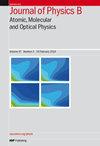量子非谐振子非线性光学感度的米勒规则推导
IF 1.5
4区 物理与天体物理
Q3 OPTICS
Journal of Physics B: Atomic, Molecular and Optical Physics
Pub Date : 2024-03-21
DOI:10.1088/1361-6455/ad369c
引用次数: 0
摘要
米勒法则是非线性光学系数与线性光学系数之间的经验关系,适用于一大类材料,但只针对具有弱非谐波扰动的经典洛伦兹模型进行过严格推导。在这项工作中,我们扩展了这一证明,并详细推导了等效量子力学非谐振荡器的米勒规则。为此,洛伦兹模型固有的速度相关阻尼的经典概念被外部电场的绝热开关所取代,这使得使用相同电势和电场的经典和量子力学系统得到了统一处理。尽管由于量子力学框架中的有限零点运动,由此产生的电荷振荡动力学以及诱导极化会出现偏差,但我们发现米勒法则在两种情况下都是相同的,直至非谐波的一阶项。考虑到实际应用,特别是在广泛假定绝热开关场的光学响应反比计算中,我们证明了正确处理有限展宽参数对于避免虚假错误至关重要,因为虚假错误可能会误导我们违反米勒规则。本文章由计算机程序翻译,如有差异,请以英文原文为准。
Derivation of Miller's rule for the nonlinear optical susceptibility of a quantum anharmonic oscillator
Miller's rule is an empirical relation between the nonlinear and linear optical coefficients that applies to a large class of materials but has only been rigorously derived for the classical Lorentz model with a weak anharmonic perturbation. In this work, we extend the proof and present a detailed derivation of Miller's rule for an equivalent quantum-mechanical anharmonic oscillator. For this purpose, the classical concept of velocity-dependent damping inherent to the Lorentz model is replaced by an adiabatic switch-on of the external electric field, which allows a unified treatment of the classical and quantum-mechanical systems using identical potentials and fields. Although the dynamics of the resulting charge oscillations, and hence the induced polarizations, deviate due to the finite zero-point motion in the quantum-mechanical framework, we find that Miller's rule is nevertheless identical in both cases up to terms of first order in the anharmonicity. With a view to practical applications, especially in the context of ab initio calculations for the optical response where adiabatically switched-on fields are widely assumed, we demonstrate that a correct treatment of finite broadening parameters is essential to avoid spurious errors that may falsely suggest a violation of Miller's rule, and we illustrate this point by means of a numerical example.
求助全文
通过发布文献求助,成功后即可免费获取论文全文。
去求助
来源期刊
CiteScore
3.60
自引率
6.20%
发文量
182
审稿时长
2.8 months
期刊介绍:
Published twice-monthly (24 issues per year), Journal of Physics B: Atomic, Molecular and Optical Physics covers the study of atoms, ions, molecules and clusters, and their structure and interactions with particles, photons or fields. The journal also publishes articles dealing with those aspects of spectroscopy, quantum optics and non-linear optics, laser physics, astrophysics, plasma physics, chemical physics, optical cooling and trapping and other investigations where the objects of study are the elementary atomic, ionic or molecular properties of processes.

 求助内容:
求助内容: 应助结果提醒方式:
应助结果提醒方式:


